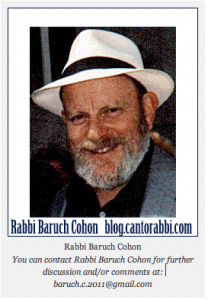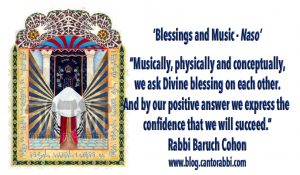BLESSINGS AND MUSIC – Naso– Num.4:21–7 – by Rabbi Baruch Cohon
Of all the topics discussed in this reading, one that comes near the end is easily the most familiar, and perhaps most important for our generation. It is identified as the Priestly Benediction, pronounced by Aaron’s sons in the ancient Temple, and by their descendants in traditional synagogues ever since. In many liberal congregations, the rabbi replaces the cohanim for the blessing.
It consists of 3 brief Hebrew sentences. Quite familiar, and often quoted – by Jews and non-Jews – at solemn ceremonies and at weddings and even at the inauguration of a president of the United States.
The first sentence, just 3 words long, vouchsafes physical safety. It drops to us as if from on High, like a gentle rain, as we are blessed with Divine protection. “May G-d bless you and guard you.”
The second one, in 5 words, lifts us to a level where Divine light can shine straight into our lives, where G-d will be kind to us as we can be kind to our friends, our equals. It inspires spiritual awareness: “May G-d’s presence shine on you and be favorable.”
And the third one’s 7 words promise peace. Says the great commentator the Klee Yokor — shocked at his own Chutzpeh – this lifts us to an even higher level. As if G-d was lifting His face toward us from below and establishing peace for us. “May G-d’s presence rise into your life and bring you peace.” That wonderful line asks for much more than the absence of armed conflict. It is addressed to each individual. It asks for peace of mind, and peace of spirit.
Verse 27 ties up the experience of the Priestly Benediction. “They (the Cohanim) shall put My name on the people of Israel,” says G-d, “and I will bless them.” The priest is reminded that he is a vessel, not the source.
A special occasion for this blessing occurs at the Western Wall on the third day of Passover. One year in Jerusalem my sons and I participated in this mass blessing. And it is a mass blessing, being a partial reenactment of the ancient pilgrimage that took place on festivals – Passover, Shavuos, Succos, when people travelled to Jerusalem from all parts of the country. The day I was there, I would estimate 100,000 Jews at the Wall. Cohanim lined the Wall, three rows deep, facing the crowd. My sons and I were among the later arrivals, so we were in the front row of Cohanim. Somewhere further down the Wall the cantor for the day — the only one with a microphone – began to cue us.
Now you must remember that the cantor always gives the cue for each word. This facilitates the Cohanim staying together as they chant, of course. But there is a religious reason too. By saying the words tothe Cohanim, the cantor in effect invokes G-d’s blessing on them first, and they then proceed to communicate that blessing to the people. As the commentators explain, you can’t pour anything out of an empty pitcher.
From under the tallis (prayer shawl) that I held in front of my face as all the Cohanim did for the blessing, I could see the first row of people packed in front of me – from the waist down. The only face I could see was a little boy about 4 years old. Wide-eyed with wonder, he took in the scene. As we began to chant the blessing, his father’s hand came around and covered the little boy ‘s eyes. Mustn’t look. In fact it is a universal Jewish custom not to look at the Cohanim during the blessing – even though their faces are covered by the tallis. Some people even turn their backs so they won’t be tempted to look. Why? Because the Cohen does not bless. The benediction is only his to deliver. G-d is the Source.
The Priestly Benediction, whether pronounced by descendants of Aaron or by clergymen, calls for an accepting answer from those being blessed. And in synagogue practice it also includes music.
Rockdale Avenue Temple in Cincinnati was a model of Classical Reform as I remember it in the ‘30’s. Among the minimal uses of Hebrew in its festival services came the Priestly Benediction, recited by the rabbi in stentorian tones (remember this was before the days of most microphones.) After he said the first line, we heard the four church singers in the choir loft in perfect harmony: “The Lord bless thee and keep thee.” Each line got a corresponding answer. Three lines. Three angelic-sounding musical responses delivered in a classical major cadence. A spell was cast.
At the other pole of observance, at the Chabad synagogue where, along with other cohanim, I now take part in the blessing on festival mornings, the prayer leader gave us a melody to introduce each word, excepting only the Divine Name. Two trademark Chabad melodies alternate, and the cohanim all have to know what phrases to repeat. At the end of each line, some 150 voices in the congregation chant “Amen” – in some 150 keys—with spirit. When we conclude the blessing, congregants shake our hands to show their appreciation.
Between these two poles we find musical expressions ranging from medium to minimal to missing. Many synagogues have the cohanim sing a melody just before the last word of each line. Others have the cohanim do a plain repetition of the cantor’s chant on each word, and the congregation responds with the words Ken y’hee ratzon – “May it be G-d’s will.” All traditional synagogues, and any liberal ones who follow the custom, have the cohanim repeat each word that the cantor chants, symbolizing the idea that they are not the source of the blessing. They are the conduit. Musically, physically and conceptually, we ask Divine blessing on each other. And by our positive answer we express the confidence that we will succeed.
The process of cohanim blessing the congregation is called dukhenen, from the word dukhan which means the low platform where the priests stand.. Experience it, next chance you get. And join in singing the response. Hear the music. Feel the echo.



